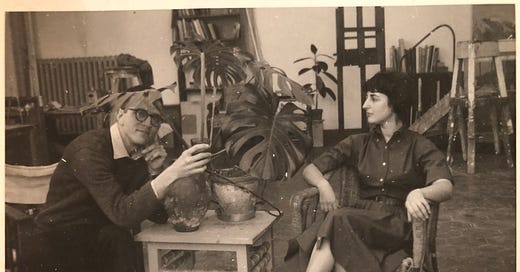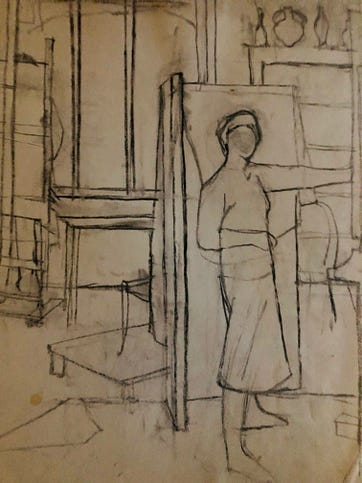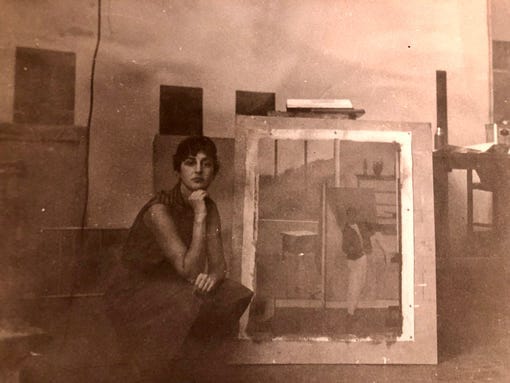Two Houses is a newsletter of stories about art, feminism, grief, and Time excavated from the Soho loft where I grew up. Posts are free and illustrated with the work of my long-divorced parents, the painters Mimi Weisbord and Lennart Anderson.
After my mother, Mimi Weisbord, moved into memory care in 2019, one of the first drawings I pulled from her drawers was this study for a self-portrait.
It is not like any work of hers I’d ever seen before. A woman standing in a very large studio with easels, platforms, windows and things behind her. The studio is so large; I suspected this was made about 1960, when she was at the American Academy in Rome with my father.
In 2019, the sketch was a thrilling find. It suggested she’d kept her earliest work. I’d yet to explore her painting closet.
Also because the moment of finding it was electric. I’d opened her flat files in her studio; I was never welcome to touch her work.
But mostly I was enthralled to glimpse this young serious Mimi, a woman in a large studio with bare feet planted. Her own artist. Her whole standing figure.
Not a nude.
In Rome, my mother posed for every female figure in Lennart’s Street Scene. Those charcoal studies hung at my grandparents’ until my mother inherited them. (My grandfather bought them in support of the young couple.) They are dramatic and lush, and the figures are nude. (I don’t have a good image, or I’d paste one here.) At the base of one, he has scrawled “Roma” adjacent to the flourish of his initials. I loved discovering that; I can see him making that mark, and I feel his satisfaction to be at the Academy with the Rome Prize. He felt on top of his game.
After Rome, she posed for Nude which is in the Brooklyn Museum’s collection (and currently on view at the Bo Bartlett Center in Georgia). That was probably in Pittsburg where they lived for a year for Lennart’s first teaching gig at Chatham Women’s College.
Finding this sketch of a clothed Mimi working in this huge studio sent a shiver through me. But I had yet to find her journal from 1980.
“I left for Rome an artist and came back a wife,” now rings in my ears.
In Woman in Black, I explained that progression, how she arrived in Rome a celebrated emerging print maker but found she didn’t have access to the print studio. How she pivoted back to painting, and at some point the Academy stopped including the work by wives of the fellows in their exhibitions, and she had nothing to paint toward.
Before I pieced that together, however, I found evidence of her early sense of belonging at the Academy in Rome (or her determination to feel that way): images of my young mother taking herself seriously as an artist. Images from before she’d decided to spend years as an artist’s wife. In the course of digging through her mounds of things, bundles of letters, drawers and boxes of photos from all eras, I was tuned to the earliest (tiniest) pictures. And how they’d connect with other artifacts.
The photo below drifted into my hands more than a year after finding the sketched self-portrait.
She is posing with the painting she made from that study. And my god, she is beautiful.
Digging through her spaces, my curiosity was rewarded again and again. I’d squint at tiny photos and make connections. The painting looks different from what I’d imagined. But I paid it little attention, overwhelmed by her self-possession. It’s the same response I had to this next photo from about the same time.
She sits regal next to my goofball father.
I’ve learned so much since finding these photos. In the first picture, I now know she didn’t like to paint on stretched canvas. In an interview of her that I found from her time at PS 1 (1979), she says that she has never liked the give of canvas, preferring to paint on a firm surface. This explains why her work-in-progress is pinned to a board (note the paint overlapping the canvas on the bottom edge).
In the second picture, I now know the photo is meant to highlight this plant. They’d bought a plant, as was popular with painters because of Matisse. This was explained, glancingly, in a letter to my grandparents. Likely, they sent them this picture, thanking them for their financial support and - by extension - their Matisse plant.
Eventually, of course, I excavated her painting racks.
And all the breadcrumbs lead to a canvas in my hands.
Are you surprised? I was. Am. Very. This picture is so strange, yet the pinks in the palette are so familiar. I love the folded corner of the rug. I am disturbed by the proportions of her pointy feet and tiny head. I’m amazed to find she dispensed with the skirt.
This artist is clothed from head to toe. And is she wearing a sweatshirt?
I have so many questions.
And I’ll never get to ask.








What a gift to have all these works of art to cherish!
She stands confidently in the painting, grounded… just as in the photo of her next to the painting. Beautiful!